

WELCOME TO THE LEARNING LAB, WHERE WE’RE ANSWERING ALL YOUR QUESTIONS ABOUT INTIMATE SKIN HEALTH - BECAUSE KNOWLEDGE IS POWER!
Today we’re bringing you the low-down on down-below health because we believe it’s a super-important, but often overlooked, part of overall well-being. We’re on a mission to help you live the sweetest life possible and vulvar health is a big part of that! Here’s what you need to know to keep your vulva healthy and happy.

Q: What’s a vulva, anyway?
A: Great question! We often hear the word “vagina” used as a blanket term for all your sweet spots, but that just isn’t accurate. The vagina is actually the internal canal connecting the uterus to the vulva. The term “vulva” refers to the external intimate area - including the pubic mound, clitoris, labia, and urethra. It’s an important distinction from both a practical knowledge and a health standpoint.
For example, our creamy cleansers are pH-balanced for vulvar skin, which is less acidic than the vagina and has a very different set of needs. Other intimate washes are pH-balanced for the vaginal canal - despite the fact that these products are intended for external (aka vulvar) use only.
Remember: vagINa is on the INside, vUlva is on the oUtside - where U can see it!
Q: How do I know if my vulva is healthy?
A: The best way to know if everything is OK down there is to take a look on a regular basis. The more familiar you are with your body, the better you’ll be able to identify anything of concern. So, grab a mirror a-la Kathy Bates in Fried Green Tomatoes and get to know yourself a bit better!
Here’s what to look for in a vulvar self-exam:
Anatomy: Notice the size and shape of the clitoral hood, clitoris, labia majora and labia minora. Keep an eye out for any changes.
Bumps: Bumps like razor bumps and ingrown hairs are common, but other types may be of concern. Check out Dr. Jill Kapf’s quick overview of bumps you should know.
Discoloration: Look for any lightening or darkening of the skin as well as any redness.
Mobility: Check to see that the clitoral hood can slide back easily to expose the clitoris.
Pain: Notice any discomfort, itch, burning or other pain.
Texture: Any thickening or thinning of the skin?
If you come across anything you’re unsure about during your self-exam, consult with your medical provider.
For more info on vulvar health, snag a copy of The Vagina Bible by Dr. Jen Gunter, follow Dr. Jill Krapf on Insta, or check out The Vulva Diaries if you’re the podcasting type.
Vulvar health is integral to your overall health and well-being, so give your vulva a little TLC. Whether it’s a self-exam or treating yourself to one of ourluxurious cleansers made specifically for vulvar skin, a healthy sweet spot is a happy sweet spot!



